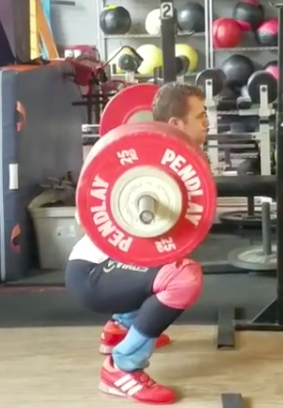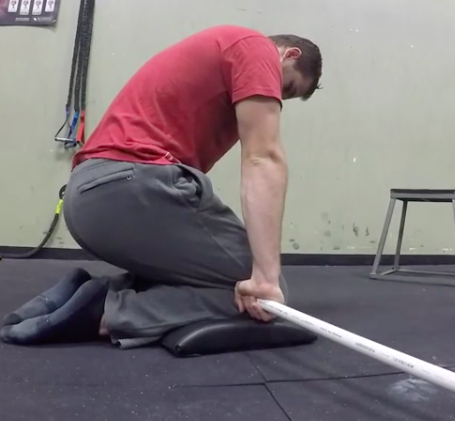There is a continuum on which movement patterns are developed. You must first develop or have mobility for a movement pattern. Mobility is the ability to get your body into the positions you want to train. You then must have stability. Stability in its broadest terms is your ability to control that range of motion/position. Once mobility and stability are obtained, then you have skilled movement. It is important to note that mobility and stability are always movement specific, not joint specific. You may have adequate shoulder mobility on the ground, but when you go to standing you lose some range of motion. The same goes for stability. Your core may be strong when you are doing planks but when you are squatting, you have no control over it.
Too often we skip the mobility and stability piece and go straight for the skilled movement patterns. For example, we want to snatch even if we do not have the capability to keep a PVC pipe over our head while doing overhead squats. We end up using the weight as counter balance and force our shoulders and spine into a compromised position to get the range of motion and stability that we cannot generate ourselves. All exercises should be able to be done with no weight. If you cannot do it without weight, you probably shouldn’t be doing it with weight. If you continue to do so without an effort to fix it, you are just reinforcing a bad movement patterns.
[thrive_leads id=’9063′]
Case Study
This past week I had my barbell class do air snatches and clean and jerks in their warm-ups. What surprised me most was that I could see their movement flaws even better with this warm-up. For those who used an early arm bend, it was still apparent with no weight. For those who had a hard time locking out their snatches or jerks, I could see their arms were still bent with no weight. For those who could not get depth, it was even more apparent here. For those who could not stabilize in the bottom (back rounds with heavy loads) I too could see that here. It was very eye opening! I think my progression/regression model will change after this experience. I want people to get to using added resistance on the barbell as fast as they can on the weightlifting movements. I want them to load it to get stronger, faster, etc. But we have to take it one step at a time. Constantly cuing and cuing and cuing may not get your athlete to the positions that they need if they are lacking mobility and stability.
We need to move well before we move often.
When cues don’t work we need to give “corrective exercises” to improve one’s mobility or stability. Mobility is the easiest to get. If done right, a lot of time you can get it really quick. Especially if you are working with younger athletes. It is thought that they have tissues that are more pliable than older adults. They have not been in compromised positions like sitting all their life yet. They are typically easier to see a change on.
How to Increase Range of Motion
My favorite models for trying to increase range of motion at a joint include soft tissue mobilization with hard objects while forcing my body into end ranges of motion. Often once I take the object away, I find that I have more range of motion before I get started. Another well studied technique is the PNF (proprioceptive neuromuscular facilitation). This includes the hold and relax techniques that you may have seen being done on hamstrings, shoulders, hips, etc. This can be done all over the body. It doesn’t have to be a specific protocol either. I often implement the soft tissue work with PNF as well. I can lay on a ball, push and contract hard onto the ball, and then relax to push my body into a further position. Other methods include classic static stretching (only after the tissue is warmed up, don’t stretch while you are cold that is wasting time).
Most mobility drills and techniques are only temporary. You are most likely not actually stretching tissue. Your nervous system is most likely getting comfortable in a new position and relaxing your body and soft tissue to allow you to get into this position. The benefits of foam rolling shows to only stick around for about 10 minutes. Some static stretching research shows that the effects can range to 30 minutes. With that, we must follow up mobility work with stability work. Once we get that new range of motion we must learn to control it. This can increase our chances of keeping the new mobility we just gained.
My favorite forms of stability work include isometrics (static holds) and tempo work. Let’s say you just improved your ankle range of motion and your sport/desired movement pattern is the squat. What we are going to do is follow up the mobility work with movement specific stability drills like pauses in the bottom of the squat pushing the knees out further over the toes. If that is too difficult we can do the same thing in a lunge position working on one leg a time. We can include some tempo work to further improve that tissues function. We can do a five-second eccentric working on proper technique, a five-second pause at the bottom, and then another three-five seconds on the way back up. SLOW IS FAST. We will make more progress going slow out of the gates when trying to achieve mobility than we will going fast.
Now We Can Load the Movement
Once the stability work is under control, then we can start to load the movement as long as our standards for the movement are agreed upon. Every movement has different movement standards that should be in place. Once you or your athlete breaks those movement standards, you must stop there until you have improved the stability of the movement pattern to add more weight.
In most athletic beginners, I commonly see they have plenty of strength to do the movements. Their strength is high coming from another sport or activity. Yet they don’t have the stability needed to get into the positions or hold the positions when the weight increases. It is important to create a buy in system with the athlete to show them where they will be in a few months. In training, it should be everyone’s goal to prevent injuries, not compromise positions for performance. Work on easier movement patterns that require less stability to maintain or increase your strength while you are working on the stability of the positions you are trying to improve.
It is important to note that this continuum will always go back and forth. You may have the stability to lift the weight you are lifting today, but in a few months you may get stupid strong (you probably are if you are following a Mash program) you may need to re-evaluate your stability in these positions. Same thing goes for mobility. If you experience an injury or you begin a new job that forces you to sit more or use your body in a different way, your body will adapt to the positions that it is in most of the time.
Want to train with Coach Matt? Check out the Mash Mafia online team!
[thrive_leads id=’8207′]

